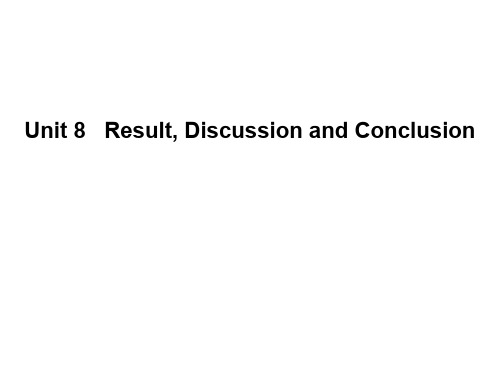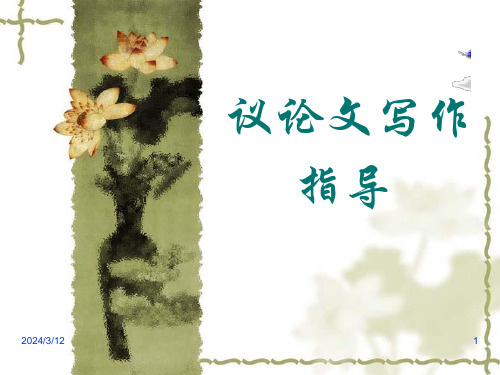论文写作discussion部分怎么写 ppt课件
合集下载
《如何写议论文》课件

并加以改进。
感谢您的观看
THANKS
论据不足或不当
01
总结词
论据是支持论点的证据,必须充分、有力、恰当。
02
详细描述
论据不足表现为支持论点的证据不够充分,无法令人信服。论据不当则
是使用了与论点不相关的证据,或者证据的真实性、可靠性存在问题。
03
解决方法
在写作前,先搜集和整理相关资料,确保拥有足够的证据支持论点。同
时,要仔细筛选证据,确保其真实可靠、与论点相关。
语言表达不准确或不严谨
总结词
语言表达是议论文的呈现方式,必须准确、严谨、流畅。
详细描述
语言表达不准确表现为用词不当、语义不明,容易引发歧义。语 言表达不严谨则是句子结构不完整、语法错误较多,影响阅读体
验。
解决方法
在写作过程中,要仔细推敲用词和句子结构,确保语言表达准确 严谨。同时,可以请老师或同学帮忙审阅文章,指出存在的问题
中间充实丰富
举例说明
通过具体事例来支持论点,使论点更有说服力。
对比论证
通过对比不同观点或事实,突出论点的正确性和重要性。
引用数据
引用相关数据来支持论点,使论点更具客观性和科学性。
结尾简洁有力
重申观点
01
在结尾部分重申文章的主要观点,加深读者对文章内容的印象
。
总结全文
02
对全文内容进行简明扼要的总结,使读者对文章有一个整体的
论点不明确或偏离主题
总结词
论点是议论文的核心,必须明确、具体,且紧扣主题。
详细描述
论点不明确表现为观点模糊、表述含糊,读者难以理解作 者的立场。论点偏离主题则是偏离了文章的中心议题,导 致论述与主题不符。
解决方法
感谢您的观看
THANKS
论据不足或不当
01
总结词
论据是支持论点的证据,必须充分、有力、恰当。
02
详细描述
论据不足表现为支持论点的证据不够充分,无法令人信服。论据不当则
是使用了与论点不相关的证据,或者证据的真实性、可靠性存在问题。
03
解决方法
在写作前,先搜集和整理相关资料,确保拥有足够的证据支持论点。同
时,要仔细筛选证据,确保其真实可靠、与论点相关。
语言表达不准确或不严谨
总结词
语言表达是议论文的呈现方式,必须准确、严谨、流畅。
详细描述
语言表达不准确表现为用词不当、语义不明,容易引发歧义。语 言表达不严谨则是句子结构不完整、语法错误较多,影响阅读体
验。
解决方法
在写作过程中,要仔细推敲用词和句子结构,确保语言表达准确 严谨。同时,可以请老师或同学帮忙审阅文章,指出存在的问题
中间充实丰富
举例说明
通过具体事例来支持论点,使论点更有说服力。
对比论证
通过对比不同观点或事实,突出论点的正确性和重要性。
引用数据
引用相关数据来支持论点,使论点更具客观性和科学性。
结尾简洁有力
重申观点
01
在结尾部分重申文章的主要观点,加深读者对文章内容的印象
。
总结全文
02
对全文内容进行简明扼要的总结,使读者对文章有一个整体的
论点不明确或偏离主题
总结词
论点是议论文的核心,必须明确、具体,且紧扣主题。
详细描述
论点不明确表现为观点模糊、表述含糊,读者难以理解作 者的立场。论点偏离主题则是偏离了文章的中心议题,导 致论述与主题不符。
解决方法
英语科技论文写作Unit 8 Result, Discussion and Conclusion PPT课件

– Lies in the value of its final results and the author’s interpretation of the results
– To bring about a solid foundation on which the whole paper rests
• While those with no meaningful functions should never appear in this section.
• The fool collects facts; the wise man selects them. (Dr. Jolin Powell)
Section of Discussion
• General Functions and Main Elements of Discussion
– To expound the interrelations among the observed facts
– To show the relationship between the facts, their underlying causes, their effects, and their theoretical implications
Section of Discussion
• General Functions and Main Elements of Discussion
– Expounding Viewpoints
• Give your judgment, evaluation, analysis, and show how your results and interpretations agree (or contrast) with previously published work.
– To bring about a solid foundation on which the whole paper rests
• While those with no meaningful functions should never appear in this section.
• The fool collects facts; the wise man selects them. (Dr. Jolin Powell)
Section of Discussion
• General Functions and Main Elements of Discussion
– To expound the interrelations among the observed facts
– To show the relationship between the facts, their underlying causes, their effects, and their theoretical implications
Section of Discussion
• General Functions and Main Elements of Discussion
– Expounding Viewpoints
• Give your judgment, evaluation, analysis, and show how your results and interpretations agree (or contrast) with previously published work.
怎样写议论文课件(幻灯片31张)

文章开头准确解释概念,给人印象清楚明确。
(七)比喻导入法。 (八)类比联想导入法。
一、议论文的整体结构
引论-----提出问题---凤头 本论----分析问题----猪肚 结论----解决问题---豹尾
二、如何环绕中心论点提炼出适当的分论点?
拟写并列分论点的角度: 1、是什么;2、为什么;3、怎么办
胜一个错误,人生就攀升到一个新的境域。我们要感谢错 误的赐予,携着错误走向光辉。
深:这是十分重要的一步。这一步是就 议论的对象进行深入的开掘,可以揭实 质,挖根源,讲意义,论危害,进行辨 证分析。在一定程度上决定文章分析质 量的高低。
联:这是深的进一步具体的深化,我特别强调, 如果能联系的话,第一应紧密联系改革开放这 个最大的现实,即使是联系个人的生活,思想, 学习的实际,也不能脱离改革开放这样一个根 本现实的制约和影响。一般说,这样联系写出 的文章立足点高,时代感强,才更有意义。这 就要求同学们及时了解党和政府的一系列有关 改革开放的大政方针,敏锐的感知社会潮流, 时代气息,人际关系等等具体的社会生活内容, 否则就无法准确的联系现实。
分论点举例
以“人要有意气”为中心论点 分论点1:人有意气才能有豁达的胸襟。 分论点2:人有意气才能摧不垮,压不倒。 分论点3:人有意气才能千古留名,流芳百世。
以“坚持就是胜利”为中心论点 分论点1:坚持需要韧性。 分论点2:坚持需要不坠之志。 分论点3:坚持需要耐得住寂寞的孤独。
以“诚实是财富”为中心论点 分论点1:诚实是做人的根本。 分论点2:诚实是处事的原则。 分论点3:诚实是求知的惟一途径。
携着错误上路
类-----错误是对真理的一次误解,对规律的一次悖逆。谁没 有犯错的时候,人生总是携着错误上路的。 人生在世,错 误总是难免,也不可怕。
(七)比喻导入法。 (八)类比联想导入法。
一、议论文的整体结构
引论-----提出问题---凤头 本论----分析问题----猪肚 结论----解决问题---豹尾
二、如何环绕中心论点提炼出适当的分论点?
拟写并列分论点的角度: 1、是什么;2、为什么;3、怎么办
胜一个错误,人生就攀升到一个新的境域。我们要感谢错 误的赐予,携着错误走向光辉。
深:这是十分重要的一步。这一步是就 议论的对象进行深入的开掘,可以揭实 质,挖根源,讲意义,论危害,进行辨 证分析。在一定程度上决定文章分析质 量的高低。
联:这是深的进一步具体的深化,我特别强调, 如果能联系的话,第一应紧密联系改革开放这 个最大的现实,即使是联系个人的生活,思想, 学习的实际,也不能脱离改革开放这样一个根 本现实的制约和影响。一般说,这样联系写出 的文章立足点高,时代感强,才更有意义。这 就要求同学们及时了解党和政府的一系列有关 改革开放的大政方针,敏锐的感知社会潮流, 时代气息,人际关系等等具体的社会生活内容, 否则就无法准确的联系现实。
分论点举例
以“人要有意气”为中心论点 分论点1:人有意气才能有豁达的胸襟。 分论点2:人有意气才能摧不垮,压不倒。 分论点3:人有意气才能千古留名,流芳百世。
以“坚持就是胜利”为中心论点 分论点1:坚持需要韧性。 分论点2:坚持需要不坠之志。 分论点3:坚持需要耐得住寂寞的孤独。
以“诚实是财富”为中心论点 分论点1:诚实是做人的根本。 分论点2:诚实是处事的原则。 分论点3:诚实是求知的惟一途径。
携着错误上路
类-----错误是对真理的一次误解,对规律的一次悖逆。谁没 有犯错的时候,人生总是携着错误上路的。 人生在世,错 误总是难免,也不可怕。
议论文写作指导课件(共25张PPT)

论点:靠奋斗冲破“埋没”的压力 例文:古今中外,许多取得了重大成就的人, 很多都遭受过“埋没”的命运。爱因斯坦就 曾被埋没在一个专利局中,充当小职员的平 凡角色。但他没有灰心,抓紧一切机会进行 研究,终于开创了物理学的新天地。华罗庚 曾“埋没”在小店铺里,但他没有消沉,每 天在做好营业工作后,抓紧一分一秒的时间, 昼夜不停,寒暑不辨,刻苦自学,潜心钻研 数学,终成著名的数学家。
二、思考讨论
观点:贫困也是一笔财富 例文:“自古才子出寒门”。司 马光出身贫寒;范仲淹两岁丧父 ,幼时连稠一点的粥都难以喝到 ;明代龙图大学士宋濂家中一贫 如洗。荷兰画家梵高也曾穷困潦 倒,一文不名,生活上常靠着弟 弟接济;苏联伟大作家高尔基曾 经是个流浪儿;居里夫人刚满十 岁就外出打工……可见贫困也是 一笔财富。
他们写议论文的时候,只会提观 点和摆材料,通篇作文没有一点 自己个人的意见和看法,这类考 生往往缺乏对事物的认知和辨析 能力,这类作文只能给到中等或 以下档次。
观点+材料=作文的失败
以叙代议
改文:……这都是幼时曾经贫困 而后来成为才子的非常之人。寒 门是他们植根的土壤,也就是这 块贫瘠的土壤使他们不断地成长, 不断地成熟,塑造自我,完善自 我,最终成为参天大树,开出灿 烂之花。由此看来,贫穷并不可 怕,可怕的是丧失摆脱贫穷的信 心和斗志。穷则思变,就要奋发 图强,越是贫困越激励人奋发上 进,这何尝又不是一笔财富呢?
四、常用方法讲解
◆果因分析法 ◆假设分析法 ◆比较分析法 ◆解说分析法
在叙述事例的基础上,对事例中的行 为,沿着“为什么”这条思路,探求其 根源,由果索因,使内容逐步深化。这 种方法叫做因果关系分析法。
标志性词语:“为什么……因为……” “正因为如此……所以……”“之所以……是因 为…… ”
二、思考讨论
观点:贫困也是一笔财富 例文:“自古才子出寒门”。司 马光出身贫寒;范仲淹两岁丧父 ,幼时连稠一点的粥都难以喝到 ;明代龙图大学士宋濂家中一贫 如洗。荷兰画家梵高也曾穷困潦 倒,一文不名,生活上常靠着弟 弟接济;苏联伟大作家高尔基曾 经是个流浪儿;居里夫人刚满十 岁就外出打工……可见贫困也是 一笔财富。
他们写议论文的时候,只会提观 点和摆材料,通篇作文没有一点 自己个人的意见和看法,这类考 生往往缺乏对事物的认知和辨析 能力,这类作文只能给到中等或 以下档次。
观点+材料=作文的失败
以叙代议
改文:……这都是幼时曾经贫困 而后来成为才子的非常之人。寒 门是他们植根的土壤,也就是这 块贫瘠的土壤使他们不断地成长, 不断地成熟,塑造自我,完善自 我,最终成为参天大树,开出灿 烂之花。由此看来,贫穷并不可 怕,可怕的是丧失摆脱贫穷的信 心和斗志。穷则思变,就要奋发 图强,越是贫困越激励人奋发上 进,这何尝又不是一笔财富呢?
四、常用方法讲解
◆果因分析法 ◆假设分析法 ◆比较分析法 ◆解说分析法
在叙述事例的基础上,对事例中的行 为,沿着“为什么”这条思路,探求其 根源,由果索因,使内容逐步深化。这 种方法叫做因果关系分析法。
标志性词语:“为什么……因为……” “正因为如此……所以……”“之所以……是因 为…… ”
医学论文格式与撰写之讨论部分PPT课件

研究结果,紧扣主题,突出重点,适当引用,适可而止。
2020/10/13
10
(2) 戒“干瘪”
诠释不足。和上述情况相反的是很多作者在写讨
论部分时,觉得无话可说,只是简单地重复各段小
标题,复述结果,给出个结论了事,使“讨论”停
留于形式,为了“讨论”而讨论,讨论的科学性和
逻辑性得不到很好地体现,得出的观点或结论自然
15
肝肿瘤能否切除或作多大范围的切除,取决于肿瘤大小、
数目、位置以及是否合并肝硬变、余肝能否维持足够的功能。
判断结果常因术者的经验、技术水平而不同,有一定的主观性。
我们体会,注重围手术期处理、熟练掌握肝脏解剖、具备有效
的控制出血手段、尽量缩短肝血流阻断时间、较多应用肝段切
除、合并门静脉癌拴或肝外浸润不列为绝对禁忌证等,对于成
钳夹、切断肝内血管、胆管。此方法简便易行,可提供良好手
术视野,显著缩短阻断时间和手术时间。对于靠近第一或第二
肝门等特殊位置的肿瘤亦可从容处理。且能够避免挤压肝脏和 肿瘤,从而减少肝癌转移的机会。
2020/10/13
16
3.2 外科综合治疗 肝癌切除术后的高复发率严重影响
其手术的远期疗效[1]。有学者指出[5],肝癌术后复发多在
关于肝血流控制、阻断,已有不少经验报道[3,4],包括入肝血流
的选择性(病侧肝门血管阻断)或非选择性阻断(第一肝门的阻
断),冷或热缺血条件下的全肝血流阻断等。我们在肝切除过程
中亦采取了多种肝血流控制措施。合理的方法应能阻断病侧肝血
流而不影响健侧肝血流,病侧肝门血管结扎加相应肝静脉结扎符
合这一要求,但解剖肝门费时费力,易至出血、损伤。常温下间
2020/10/13
议论文论证部分的结构ppt课件

并列式
01
对比式
02层进式03主来自部分的结构:一、并列式①:
引论(提出论点) (正面) 论据① +分析论证 本论 ( 正面) 论据② +分析论证 (反面) 论据③ +分析论证 结论(照应全文)
模式1:
论据并列
《高尚不需要理由 》
高尚不需要理由
千载胡曲,琵琶声声传驿道
高考作文对结构的要求
对策
文章无定法,作文有常规。掌握几种基本的结构模式,能使我们在考场上快速构思,在较短的时间内迅速搭起文章的骨架。 考场作文通常可分为三个部分,即开头,结尾和主体。主体部分最常见的结构有三种:并列式;对照式;层进式。 段落是具体而微的文章,并列式、对照式、层进式不仅可以用来谋篇,也可以用来构段。
有时改变也是一种美丽。蒋丽雯、比尔盖茨的改变是正确的,因为改变,他们演绎了不同的精彩人生。然而翻开浩翰的历史画卷,有的人却醉生梦死,不知变通。孔乙己,清朝末期的一个穷酸秀才,立志过上有钱人家的生活,于是他选举中举这条道路,读死书,中状元。但是他的命并不好,几次考试都没有,他不知改变自己这一条路,最终落得一个悲惨的结果。
但曾在二战中犯下罄竹难书罪行的日本却没有学会重新开始。“脆着的德国人比站着的日本人更高大!”便是世人对日本人的讽刺,他们鼓吹“中国危胁论”,不顾史实修订教科书,参拜靖国神社,面对历史,他们没有去反省,而是一味地去文饰、去美化。他们还没有成长。正如雨果所说的“被人揭下面具是一种失败,自己揭下面具是一种胜利”。
模式2:
更能显示思辨的深度
中心论点:家 家是亲情的港湾,装载着幸福; 家是友情的寄托,承载着快乐; 家是永远的牵挂,搭载着甜蜜;
拟写(设分论点)分论点角度 从“是什么”设分论点
01
人生 三境界
《如何撰写学术论文》PPT课件

(4): 203~222
4 谌颖. 空间最优交会控制理论与方法研究. 哈尔滨工业大学博士论文.
1992:8~13
5 S. Niwa, M. Suzuki and K. Kimura. Electrical Shock Absorber for Docking
System Space. IEEE International Workshop on Intelligent Motion Control,
.
13
研究生学位论文撰写规范
• 论文正文(包括绪论、论文主体及结论等部分)
–论文正文字数
• 理工科一般为2~3万字
–公式、插图、插表
• 按章编号
–插表
• 表格不加左、右边线
• 表题(由表序和表名组成)置于表上,用中、英文两种文字居中排 写,中文在上(MSE论文可以不要英文) ,要求用5号字
–插图
• 流程图:符合结构化程序流程图规范
2 J. R. McDonnell, D. Wagen. Evolving Recurrent Perceptions for Time-Series
Modeling. IEEE Trans. on Neural Networks. 1994,5(1):24~38
3 X.Yao. Evolutionary Artifitial Neural Networks. J. Of Neural Systems. 1993,
学术会议文献 序号└┘作者.文章名.编者名.会议名称,会议地址,年份.出版地,出版者,出版年: 引用部分起止页
学位论文类参考文献 序号└┘研究生名.学位论文题目.学校及学位论文级别.答辩年份:引用部分起止页
.
《论文撰写讲座》课件

《论文撰写讲座》 ppt课件
目录
• 论文撰写概述 • 论文选题与资料收集 • 论文结构与大纲 • 论文写作技巧与规范 • 论文修改与完善 • 论文答辩与评价
01
论文撰写概述
论文的定义与特点
总结词
阐述论文的基本概念和特点
详细描述
论文是一种学术性文章,旨在探讨某一领域的问题或现象,通过收集、分析和解释数据,得出 结论并提出建议。论文具有以下特点:科学性、创新性、客观性、严谨性和规范性。
02
论文选题与资料收集
选题的原则与技巧
原则
重要性、创新性、可行性
创新性
研究角度、方法、观点具 有新颖性
重要性
选题对学科发展、社会进 步有重要影响
选题的原则与技巧
• 可行性:具备完成选题的主客观条件 • · 可行性:具备完成选题的主客观条件
选题的原则与技巧
技巧 关注学术热点和前沿问题
从实际出发,结合自身兴趣和专业背景 善于发现和解决问题
准确无误
确保语言表达准确,避免歧义和模糊不清的情 况。
生动形象
运用比喻、拟人等修辞手法,使语言更具表现力和感染力。
逻辑思维的训练
结构清晰
合理安排论文结构,使文章层次分明、条理 清晰。
论证严密
在论述观点时,要提供充分的论据和证据, 确保论证严密。
逻辑连贯
保持文章内部的逻辑连贯性,避免出现前后 矛盾的情况。
04
获取官方数据和资料
文献综述的撰写
目的:全面梳理相关研究,找出研究空白和研 究趋势
01
确定主题和范围
03
02
步骤
04
搜集和筛选文献
分类整理和归纳总结
05
06
目录
• 论文撰写概述 • 论文选题与资料收集 • 论文结构与大纲 • 论文写作技巧与规范 • 论文修改与完善 • 论文答辩与评价
01
论文撰写概述
论文的定义与特点
总结词
阐述论文的基本概念和特点
详细描述
论文是一种学术性文章,旨在探讨某一领域的问题或现象,通过收集、分析和解释数据,得出 结论并提出建议。论文具有以下特点:科学性、创新性、客观性、严谨性和规范性。
02
论文选题与资料收集
选题的原则与技巧
原则
重要性、创新性、可行性
创新性
研究角度、方法、观点具 有新颖性
重要性
选题对学科发展、社会进 步有重要影响
选题的原则与技巧
• 可行性:具备完成选题的主客观条件 • · 可行性:具备完成选题的主客观条件
选题的原则与技巧
技巧 关注学术热点和前沿问题
从实际出发,结合自身兴趣和专业背景 善于发现和解决问题
准确无误
确保语言表达准确,避免歧义和模糊不清的情 况。
生动形象
运用比喻、拟人等修辞手法,使语言更具表现力和感染力。
逻辑思维的训练
结构清晰
合理安排论文结构,使文章层次分明、条理 清晰。
论证严密
在论述观点时,要提供充分的论据和证据, 确保论证严密。
逻辑连贯
保持文章内部的逻辑连贯性,避免出现前后 矛盾的情况。
04
获取官方数据和资料
文献综述的撰写
目的:全面梳理相关研究,找出研究空白和研 究趋势
01
确定主题和范围
03
02
步骤
04
搜集和筛选文献
分类整理和归纳总结
05
06
《论文写作》PPT课件 (2)

选
题
•提高餐饮业培训质量的原因分析和对策
•网络营销对酒店的影响
•大堂副理设置和应注意的问题初探
•饭店培养“回头客”的方法探讨
•酒店需要“个人关注服务”
•论酒店管理人员的职业化
•公共关系是现代饭店管理发展的重要保证
•对中式快餐发展的重要因素分析
•环保意识与“绿色酒店”
选
•酒店智能化技术初探
题
二、论文写作的 准备、立意与构
【关 键 词】现代旅游 市场需求 发 展趋势 多样化 个性化
论人民币的自由兑换
山西财经大学金融系 王丽珠
摘要: 货币的完全自由兑换是一国经济发展到一定阶
段的必然结果。资本项目的对外开放在使一国享受 到许多现实利益的同时可能付出一些代价。中国应 趋利避害,不断完善实现自由兑换的各项条件,循序 渐进,逐步到位。 关键词:
(一)检索相关的素材
占有的素材越多,就越容易从中发现规律性 和普遍性的东西,从而为下一步提炼观点打下扎 实的基础 。
搜集素材的途径
收集现有书面材料
调查研究中得到的材 料
(二)分析、研究、确立论点
例如:
• 《关于开发利用恭王府之可行性初探》
作者从“恭王府的今昔”、“恭王府的 旅游价值”、“开发、利用恭王府的必要性与依据” 、“关于再现‘人间大观园’的初步设想”、 “技 术可行性的初步分析”、“经济可行性的初步研究” 等六个问题的探讨中,确立了本文的中心:恭王府具 有历史文物价值,对旅游者有较大的吸引力,经过重 新修整.可以开辟为北京城内一个新的旅游点。
第八章 论文写 作
第一节 科技论文概述
一、概念和特点 (一)科技论文的概念 科技论文是论述科技领域中具有创新意义的理论性、实验性
议论文写作指导(优秀实用)PPT课件

2024/3/12
16
常见的四种论证方法:
论证方法也是议论文三要素之一,它是指运用论据来证明论 点的过程和方法。是论点与论据之间逻辑关系的纽带。如果 说论点解决“需要证明什么”的问题,论据解决“用什么来 证明”的问题,那么论证方法则用来解决“怎样证明”的问 题。
1、举例证法:运用典型事例论证观点
2、引用论证:用名人名言谚语论证观点
2024/3/12
7
发现影响深远的万有引力定律,引起了物理 学界的革命,或许在牛顿以前,也有人被掉 落的苹果砸到,但只会抱怨,没有抓住深入 思考的机遇。而善于思考的牛顿却抓住了这 个降落到自己头上的“机遇”,为力学的发 展开辟了道路。[摆事实讲道理]
机遇是公平的,当机遇摆在人面前时, 有人抓住了,有人却失之交臂。
阻,挫折失败。在危困时刻,有人向你伸出温暖的双手,解除 困顿;有人为你指点迷津,指明方向……最终你战胜了苦难, 扬帆远航,驶向彼岸。那么,你能不心存感激吗?你能不思回 报吗?不能!你应该心存感激,并通过十倍、百倍的付出,用 实际行动予以回报。
3.引用名言式:日本前首相田中角荣的座右铭是他母亲教
导他的一句话:“别人向你借的钱﹐你可以忘记;你向别人借 的钱,一定不能忘记。”“别人向你借的钱﹐你可以忘记”不 难理解,那么,“你向别人借的钱”﹐为什么“一定不能忘记” 2呢024﹖/3/1我2 想,除了诚信的要求外,更是说明了知恩必须图报。 25
1.直起——开门见山
开宗明义,直接点题.简洁明了,干脆利落, 将议论的中心问题鲜明突出地提了出来 。
2.疑起——设问作答
用设疑开头,预作铺垫,借以蓄势,引出后文, 启人思迪。问中含奇,话外有意,既点明了文章主题, 又有助于全文的展开,可谓一箭双雕。
《议论文的写作技巧》PPT课件

精选ppt
37
曲折也是一种美丽
“间关莺语花底滑,幽咽泉流水下难”,
这是唐代诗人白居易对音乐曲折委婉的传神
描写;“今日一山明日一洞,八十一难在其
中”,这是明代吴承恩对小说情节曲折动人
的生动刻画;“好事多磨”,这是千百年来
劳动人民对事物总是曲折前进的朴素回答。
“莫言下岭便无难,赚得行人空喜欢。正入
万山圈子里,一山放出一山拦。”曲折,其
泛滥的波浪;信念是熊熊烈火的引星,没有它,就只有
一把冰冷的柴把;信念是远洋巨轮的主机,没有它,就
只剩下瘫痪的巨架。
只有启程,才会到达理想的目的地,只有拼搏,才
会获得辉煌的成功,只有播种,才会有收获。只有追求,
才会品味堂堂正正的人。精选ppt
22
例二:
如果忘记是春天里消逝的冰层,那么铭记就是 灼灼其华的桃花;如果忘记是夏天里落英缤纷的桃瓣, 那么铭记就是映日别样红的荷花;如果忘记是秋天里已 无擎雨盖的荷花,那么铭记就是犹有傲霜枝的金菊;如 果忘记是冬季里比西风更瘦的残菊,那么铭记就是傲雪 独立、犹有暗香的雪梅!
精选ppt
14
作文欣赏一:
•
夜深人静之时,静静地独坐窗前,任思绪 飘飞。世间繁花似锦、车水马龙皆在脑海中浮 动。学会静静地思考是一种生活的享受,是一 次心灵洗礼的过程。我们应该学会思考,开启 思考的窗户,欣赏生活之美。
1、思考是创造奇葩的明灯。
2、思考是勇攀高峰的绳索。
3、思考是人生路上的幸福。
姜雪 《开启思考的窗户》
实也是一种美丽,何必“空喜欢”呢?
精选ppt
38
写好本论的技巧
精选ppt
39
合理布阵,打造本论
1、本论部分布局方式之一——并列组合,有条有理
讨论与结论写作方法PPT课件

➢ Emphasizing difference: present a point-by-point contrast of difference in descending order of importance, then the points of comparison or similarity
• 撰写讨论时要避免含蓄, 尽量做到直接、明确, 以便 审稿人和读者了解论文为什么值得引起重视 (Place your results in a wider context)
“Selling” my data!
第2页/共22页
讨论:基本内容
• 对结果提出说明、解释或猜测; 根据这些结果, 能得出何种结论或推论? • 指出研究的局限性以及这些局限对研究结果的影响; 并建议进一步的研究题目或方
第14页/共22页
• 在叙述自己研究工作的主要结论时,通常可使用现在时以及推测动词(如appears, seems等)或情态动词 (如may、could等)。 The lateral bucking capacity of beams with transverse loads are affected by the location of applied load as well as the fiber orientation. (lateral:横(向)的;bucking:补偿的;transverse load:横向负载;fiber orientation:纤维定向作用)
第11页/共22页
时态
概述研究活动
结论部分的第一个句子或前几个句子常常是对研究目的或主要研究活动 的概述(不少作者不写概述而直接叙述主要结论)。 – 文章使用“论文导向”时,研究活动的概述常用现在完成时。 This paper has conducted the search for a practical magnetocaloric cooling configuration for the large near-room temperature refrigeration and air conditioning market.
• 撰写讨论时要避免含蓄, 尽量做到直接、明确, 以便 审稿人和读者了解论文为什么值得引起重视 (Place your results in a wider context)
“Selling” my data!
第2页/共22页
讨论:基本内容
• 对结果提出说明、解释或猜测; 根据这些结果, 能得出何种结论或推论? • 指出研究的局限性以及这些局限对研究结果的影响; 并建议进一步的研究题目或方
第14页/共22页
• 在叙述自己研究工作的主要结论时,通常可使用现在时以及推测动词(如appears, seems等)或情态动词 (如may、could等)。 The lateral bucking capacity of beams with transverse loads are affected by the location of applied load as well as the fiber orientation. (lateral:横(向)的;bucking:补偿的;transverse load:横向负载;fiber orientation:纤维定向作用)
第11页/共22页
时态
概述研究活动
结论部分的第一个句子或前几个句子常常是对研究目的或主要研究活动 的概述(不少作者不写概述而直接叙述主要结论)。 – 文章使用“论文导向”时,研究活动的概述常用现在完成时。 This paper has conducted the search for a practical magnetocaloric cooling configuration for the large near-room temperature refrigeration and air conditioning market.
- 1、下载文档前请自行甄别文档内容的完整性,平台不提供额外的编辑、内容补充、找答案等附加服务。
- 2、"仅部分预览"的文档,不可在线预览部分如存在完整性等问题,可反馈申请退款(可完整预览的文档不适用该条件!)。
- 3、如文档侵犯您的权益,请联系客服反馈,我们会尽快为您处理(人工客服工作时间:9:00-18:30)。
The work was done in the past, but knowledge exists in the present. Examples • Three Cr3+ compounds were examined. (work done in the past) • Hydroxyl radical is a known mediator of DNA damage.
(knowledge that exists in the present)
Notes: Interpretations and mechanisms in Discussion section are often present tense active voice.
3. Use of ”We”
Analyzing Organization
Note: The order in which you present findings (in Results) and interpret findings (in Discussion) should be parallel.
➢ Note
Two additional submoves, associated with move 2, that are less common today than in the past: (1) indicate limitations of the work (2) suggest ideas for future work Thus, as you prepare your paper, check to see if these submoves are expected in Discussion sections in your targeted journal.
The word we (used to refer to the authors of the work) is commonly used to achieve the following purposes in the Discussion section:
✓ To indicate a decision or course of action ✓ To compare findings with previous works ✓ To offer an interpretation ✓ To report or summarize findings
Organize a Discussion section following the major moves: • Interpret your results (but avoid overinterpretation) • Describe the greater importance of your findings • Follow appropriate writing conventions
Chapter 5:Writing the Discussion Section
报告人:孙岩 2018.6.8
Purposes
The Discussion section can stand alone or can be part of a combined Results and Discussion (R&D) section. In either case, it serves the same major purpose: to interpret the results of the study.
1. Hedging words
Words should be used to clarify, not convince. Chemists soften their interpretations and claims to “truth” by using hedging words.
×
2. Tense and voice
evidence.
scientific community?)
Such words as fact, truth, and prove are rarely used in a Discussion section. Hedging words, such as theory and evidence, are much more common, as are such verbs as appear, indicate, seem, and suggest. By hedging, writers acknowledge that their knowledge is limited and will be subjected to scientific scrutiny over time.
In the discussion section:
interpret their data
address why and how questions (e.g., Why was
the reaction faster? How did the mechanism
proceed?)
extend their findings to a larger context (e.g.,
Move 1 Discuss specific results
Move 2 Conclude the paper
直接Move 2
Remind readers of the results
Interpret ults
Suggest overall implications Summarize the work
Note : Be careful not to overinterpret your data, misinterpret your
Wrehsualtsv, oavleursetawte iylolutrhaesssuemfpitinodnsi,nogr sstrhaayvtoeo tfoartfhroem scientific
(knowledge that exists in the present)
Notes: Interpretations and mechanisms in Discussion section are often present tense active voice.
3. Use of ”We”
Analyzing Organization
Note: The order in which you present findings (in Results) and interpret findings (in Discussion) should be parallel.
➢ Note
Two additional submoves, associated with move 2, that are less common today than in the past: (1) indicate limitations of the work (2) suggest ideas for future work Thus, as you prepare your paper, check to see if these submoves are expected in Discussion sections in your targeted journal.
The word we (used to refer to the authors of the work) is commonly used to achieve the following purposes in the Discussion section:
✓ To indicate a decision or course of action ✓ To compare findings with previous works ✓ To offer an interpretation ✓ To report or summarize findings
Organize a Discussion section following the major moves: • Interpret your results (but avoid overinterpretation) • Describe the greater importance of your findings • Follow appropriate writing conventions
Chapter 5:Writing the Discussion Section
报告人:孙岩 2018.6.8
Purposes
The Discussion section can stand alone or can be part of a combined Results and Discussion (R&D) section. In either case, it serves the same major purpose: to interpret the results of the study.
1. Hedging words
Words should be used to clarify, not convince. Chemists soften their interpretations and claims to “truth” by using hedging words.
×
2. Tense and voice
evidence.
scientific community?)
Such words as fact, truth, and prove are rarely used in a Discussion section. Hedging words, such as theory and evidence, are much more common, as are such verbs as appear, indicate, seem, and suggest. By hedging, writers acknowledge that their knowledge is limited and will be subjected to scientific scrutiny over time.
In the discussion section:
interpret their data
address why and how questions (e.g., Why was
the reaction faster? How did the mechanism
proceed?)
extend their findings to a larger context (e.g.,
Move 1 Discuss specific results
Move 2 Conclude the paper
直接Move 2
Remind readers of the results
Interpret ults
Suggest overall implications Summarize the work
Note : Be careful not to overinterpret your data, misinterpret your
Wrehsualtsv, oavleursetawte iylolutrhaesssuemfpitinodnsi,nogr sstrhaayvtoeo tfoartfhroem scientific
